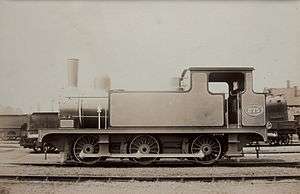GER Class T18
The GER Class T18 was a class of fifty 0-6-0 tank steam locomotives designed by James Holden for the Great Eastern Railway. They passed to the London and North Eastern Railway at the grouping in 1923 and received the LNER classification J66.
| GER Class T18 LNER Class J66 | |||||||||||||||||||||||||||||||||||||
|---|---|---|---|---|---|---|---|---|---|---|---|---|---|---|---|---|---|---|---|---|---|---|---|---|---|---|---|---|---|---|---|---|---|---|---|---|---|
 Class T18 locomotive No. 275 | |||||||||||||||||||||||||||||||||||||
| |||||||||||||||||||||||||||||||||||||
| |||||||||||||||||||||||||||||||||||||
| |||||||||||||||||||||||||||||||||||||
| |||||||||||||||||||||||||||||||||||||
Overview
When James Holden took office on the Great Eastern, there were few 0-6-0T locomotives, most shunting being done by 0-4-4T and obsolete tender locomotives.
These small locomotives had 16 1⁄2-by-22-inch (419 by 559 mm) cylinders, 4-foot-0-inch (1.219 m). coupled wheels and a grate area of 12.4 sq ft (1.15 m2). They were rebuilt between 1898 and 1908.[1]
| Year | Order | Builder | Quantity | GER Nos. | LNER Nos. | Notes |
|---|---|---|---|---|---|---|
| 1886 | T18 | Stratford Works | 10 | 275–284 | 7275–7284 | |
| 1887 | K19 | Stratford Works | 20 | 285–304 | 7285–7304 | |
| 1888 | H21 | Stratford Works | 10 | 307–316 | 7307–7316 | |
| 1888 | T21 | Stratford Works | 10 | 317–326 | 7317–7326 | |

Withdrawals started in 1936 when four (7278, 7287, 7303 and 7308) were sold to Sir Robert McAlpine and Son, the latter concern also having five on loan from late 1936 to mid-1938. Three others were sold, with No. 297 going to the Mersey Railway in 1939 as their No. 3 to work ballast trains. By the end of 1940, thirty-one had been withdrawn, and the remaining 19 locomotives continued with no further retirements until 1950. In the LNER 1944 renumbering plan, the locomotives were renumbered 8370–8388. Withdrawal restarted in 1950 and all were gone by the end of 1955.
In 1952, Three locomotives, 8370 and 8378, and 8382 were transferred to the service list as 32, 36, and 31 respectively.
References
Notes
- Allen et al. 1970, pp. 73–77
- Aldrich 1969, p. 100.
Bibliography
- Aldrich, C. Langley (1969). The Locomotives of the Great Eastern Railway 1862–1962 (7th ed.). Wickford, Essex: C. Langley Aldrich. OCLC 30278831.
- Allen, D. W.; Boddy, M. G.; Brown, W. A.; Fry, E. V.; Hennigan, W.; Manners, F.; Neve, E.; Proud, P.; Roundthwaite, T. E.; Tee, D. F.; Yeadon, W. B. (November 1970). Fry, E. V. (ed.). Locomotives of the L.N.E.R., part 8A: Tank Engines - Classes J50 to J70. Kenilworth: RCTS. ISBN 0-901115-05-3.
External links
| Wikimedia Commons has media related to GER Class T18 / LNER Class J66. |
- J. Holden locomotives — Great Eastern Railway Society
- The Holden J66 (GER Class T18) 0-6-0T Locomotives — LNER Encyclopedia